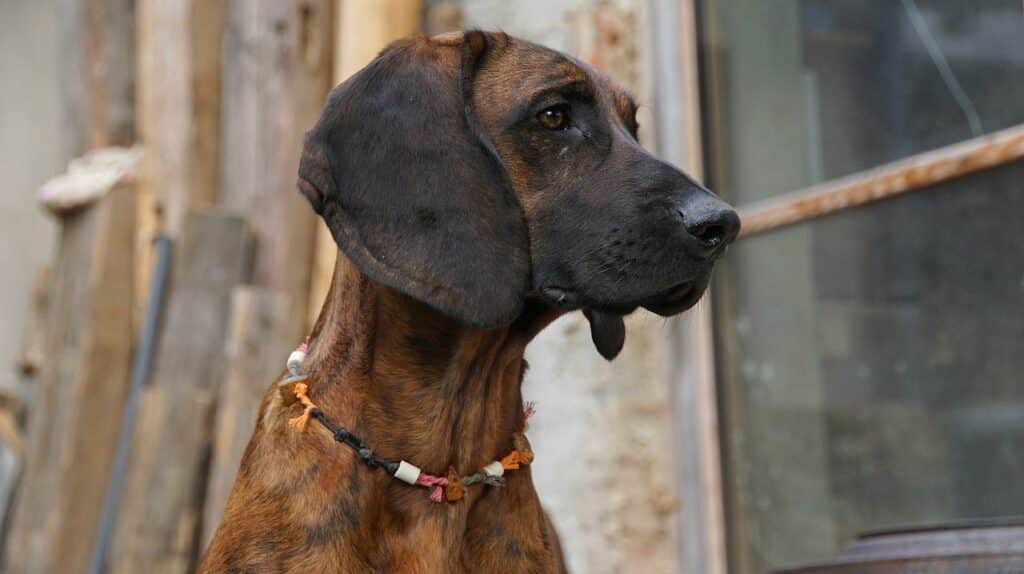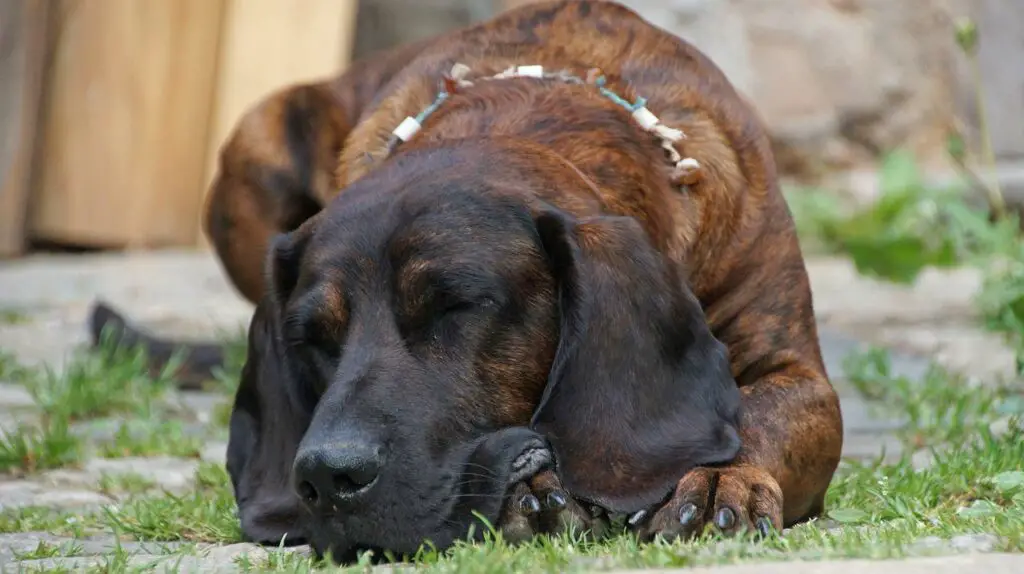You are probably looking for a family pet and have finally settled on a bloodhound.
You can’t go wrong with a bloodhound as they are relaxed and friendly companions, the perfect addition to your family.
You, however, wonder how much grooming your bloodhound will need and if he sheds excessively.
So, do bloodhounds shed a lot?
Yes. Bloodhounds shed, but it’s more pronounced during spring and fall.
In spring, your canine sheds more fur in readiness for the warm weather, while in fall, the furry coat changes in preparation for winter.
Let’s delve deeper into how much a bloodhound sheds, the grooming process, and how you can manage the molting.

Why bloodhounds shed ?
Bloodhounds have a short and dense coat that is either a mixture of liver and tan, black and tan, or red.
They are great trackers and have a sharp sense of smell.
This explains why they are a favorite in the police departments.
Shedding is normal in dogs, and bloodhounds rid themselves of old and damaged fur throughout the year.
They, however, shed more seasonally during spring and autumn as they prepare for climate change.
Shedding during spring
As temperatures rise in spring, your canine will shed off their thicker winter coat for a thinner one leaving hair on your clothes, carpets, and furniture.
The shedding helps the bloodhound regulate body temperature and avoid overheating during warm weather.
As the fur sheds, it may appear uneven with visible patches at first but evens out as the season progresses.
The shedding takes about 2-3 weeks.
Shedding during autumn
Bloodhounds shed their summer coats in the fall to accommodate a heavier protective coat for the winter.
The shedding makes room for a heavier coat which keeps the bloodhound warm during the winter and helps regulate body temperature.

Other reasons why the bloodhound sheds
It’s essential to know your canine’s shedding pattern.
Shedding which is out of the norm could be an indication of health issues that are exhibited through:
Skin allergies: When your furry friend is exposed to allergens in the environment, diet, medication, or a product, it may increase shedding.
When you notice excessive shedding, which is unusual, try to identify the cause and contact your veterinarian for a solution.
Skin parasites: Excessive shedding can also be a result of parasitic infestation.
Ticks, mites, and fleas are parasites that can cause scratching and itching in your canine, leading to skin inflammation, loss of fur, skin conditions, and other health issues.
Skin conditions: Dermatitis, ringworms, fungal and bacterial infections are another cause of unusual molting, where the affected part of the skin losses fur, leaving patches.
You can tell your dog has parasites because they tend to itch a lot and have inflamed skin.
Stress: Major changes such as moving houses, change of environment, mistreatment, or being left alone for long can cause your bloodhound stress.
Once prolonged, the stress can cause your canine to lose some fur.
Poor nutrition: A poorly fed dog or one that doesn’t get a healthy meal lacks the proper nutrients to sustain healthy skin and fur.
Poor nutrition may cause your bloodhound to be prone to disease and unusual shedding.
Hormonal imbalance and other underlying diseases: Spaying, neutering, and giving birth are experiences that may cause your dog hormonal imbalances leading to excessive fur loss.
Shedding, especially on certain body parts, can also indicate thyroid disease, Cushing’s disease, inflammatory bowel disease, tumors, and fungal or bacterial infections.
Contact your veterinarian immediately if you notice unusual shedding accompanied by symptoms like:
- Vomiting
- Diarrhea
- Skin discoloration
- Loss of appetite
- Confusion
- Increased thirst
- Increased urination
What to do when your bloodhound has unusual shedding?
If you notice irregular shedding in your dog, try to find the causes.
Identify the factors that may cause the condition, including medication, a new shampoo, or parasitic infestation.
Seek advice from your veterinarian when you notice irregular shedding in your furry friend.
Signs to keep an eye out for are:
- Dull fur
- Excessive hair loss
- Patches and baldness
- Itching and scratching
- Skin inflammation
How to manage your bloodhound’s shedding?
Frequent brushing
To reduce the amount of fur in your home, particularly during seasonal shedding, brush your bloodhound twice a week with a medium bristle brush or a hound glove.
A hound rubber glove removes the excess hair easily and helps massage and distribute your dog’s natural oils, boosting a healthier and glossy coat.
Clean your dog
The fur around your bloodhound face is softer than the rest of the body.
Wipe down the wrinkles and folds daily, especially after meals, to keep your canine dry and avoid infection and bacterial buildup.
Wash your canine when required with suitable dog shampoos.
Bloodhounds have an odor, and you may be tempted to wash your dog more often to eliminate the smell.
That may not be necessary as it’s a natural smell that won’t go away even with intense washing.
Be consistent
Consistency will make grooming easier, as your dog will know what to expect and when.
Build the routine when still a pup.
This encourages your furry friend to be well-behaved during grooming.
You can also use his favorite toy to distract him.
Proper nutrition
A wholesome diet that includes all the nutrition and minerals necessary for your canine’s healthy growth is imperative, especially during the shedding period.
Your furry friend will enjoy great skin and glossy fur.
Professional groomer
An experienced professional groomer can train you to use the right tools to groom your fur buddy and manage the molting.
Vacuum cleaner
Invest in a good, powerful vacuum cleaner to ensure it picks up all fur that has been shed around your home, especially on carpets and furniture.
Final thought
Bloodhounds are gentle, lovable dogs and a joy to have in a household.
Their love for people, especially children, and other pets, make them easy home companions.
They may need frequent grooming to maintain their skin and fur and control the shedding but are fun to have around.
- What Dog Breeds Have Pink Skin? - March 24, 2023
- What Are the Most Inspiring Dog Breeding Quotes? - March 20, 2023
- Can Pheromone Spray Help Improve Dog Breeding Results? - March 19, 2023








